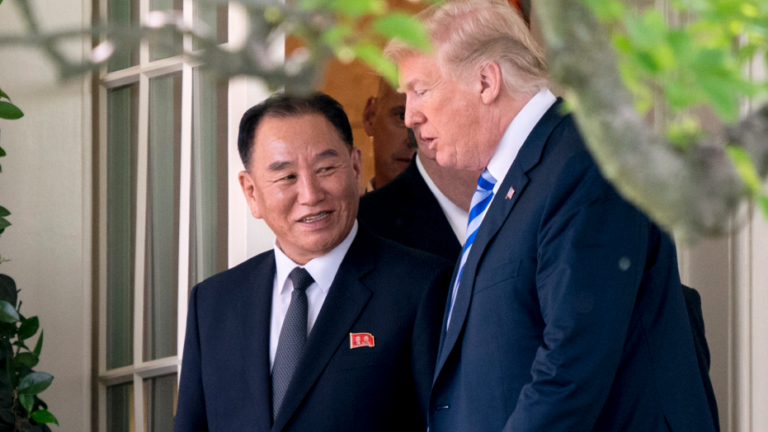Even by President Donald Trump’s mercurial standards, it was a quick shift.
A week after abruptly canceling his historic summit with Kim Jong Un, Trump announced it was back on — and in the process appeared to accede to a key North Korean demand.
Beyond the symbolism of Friday’s Oval Office meeting between Trump and Kim Yong Chol — the most senior North Korean official to step inside the White House in 18 years — Trump signaled a subtle change in his administration’s approach toward the goal of getting the pariah nation to give up its nuclear weapons.
U.S. officials have previously been calling for North Korea to abandon its nukes rapidly, with the expectation of getting benefits afterward in the form of security assurances, sanctions relief and the opportunity to boost its meager economy.
But as he spoke to reporters Friday, Trump repeatedly referred to the June 12 summit in Singapore — a first between the leaders of the U.S. and North Korea — as the start of a “process,” and said it was likely that more than one meeting would be necessary to bring about his goal of denuclearizing the Korean Peninsula.
“June 12th, we’ll be in Singapore,” Trump said after his lengthy goodbye with Kim Yong Chol, a former North Korean military intelligence chief, whom he escorted to a black SUV. “It will be a beginning. I don’t say and I’ve never said it happens in one meeting. You’re talking about years of hostility; years of problems; years of, really, hatred between so many different nations. But I think you’re going to have a very positive result in the end.”
Trump gave no indication of what kind of timetable he might have in mind for getting North Korea to abandon a weapons program it views as a guarantee for the survival of its authoritarian regime. Still, his comments marked a sea change from the views expressed weeks earlier by his national security adviser John Bolton, who was notably absent from Friday’s meeting.
Bolton, who before taking office in April advocated military action against North Korea, had pointed to the disarmament of Libya in 2003 and 2004 in exchange for sanctions relief as a model for a possible deal with North Korea. For the North, that was a deeply provocative comparison, because Libyan autocrat Moammar Gadhafi was killed following U.S.-supported military action in his country about seven years after giving up his fledgling nuclear program.
Rather than surrender its program all at once as Gadhafi did, North Korea has repeatedly said it envisions a “progressive and synchronous” approach, where it gets benefits along the way. The latest expression of that came Thursday from Kim Jong Un himself when he met in Pyongyang with Russian Foreign Minister Sergey Lavrov.
In a dispatch Friday, North Korean state news agency cited Kim saying “he hoped that the DPRK-U.S. relations and the denuclearization of the Korean peninsula will be solved on a stage-by-stage basis.” DPRK refers to the North’s official name, the Democratic People’s Republic of Korea.
That sounds reminiscent of past U.S. efforts to negotiate North Korea’s disarmament with incentives of aid since the mid-1990s — efforts that have ultimately failed. The Trump administration has often said it can’t afford to repeat those mistakes because of the threat that North Korean nuclear-tipped missiles now pose to the continental U.S.
But there’s always been doubt about whether it was realistic to expect instant results — both because of North Korea’s negotiating position and the scale and sophistication of its weapons program.
This week, Stanford University experts — including nuclear physicist Siegfried Hecker, who has inspected North Korea atomic facilities firsthand — proposed a denuclearization road map spanning 10 years. They warned that the idea of shipping the North’s nuclear weapons out of the country was “naive and dangerous.”
North Korea has shown some goodwill: halting missile tests for six months so far, and last week demolishing key areas of its nuclear test site in front of international journalists. It has also released three American detainees.
Now Trump, keen to strike a historic deal with a bitter U.S. adversary, appears eager for rapprochement to work. After meeting Kim Yong Chol, the president said he was putting new sanctions against the North on hold and doesn’t want to use the term “maximum pressure” anymore — referring to his signature policy to isolate Pyongyang economically and diplomatically.
That may ease fears of renewed confrontation that fueled fears of war last year. But doubts linger about North Korea’s intentions.
By hosting a top official from the North — whose trip to New York and Washington required waiving a travel ban against him — Trump has provided an early public relations victory for an isolated government eager for international recognition. He’s also generated considerable expectations about how the summit can herald a warm relationship between longstanding enemies.
Hawks in the U.S. administration may also be concerned that Trump, who often complained during his election campaign about American military burdens overseas, would ultimately agree to a timetable for denuclearization by North Korea in exchange for withdrawing American troops from South Korea — removing a military tripwire to deter aggression by the North.
(AP)











